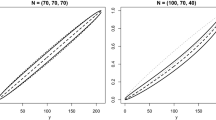Abstract
Inequalities on orderings of independent random variables are derived in the context of random utility models for ranking and subset choice data. The inequalities can be used to assess whether ranking or subset choice data are consistent with an independent random utility model. The main technique used for the inequalities is “association”, with conditions for the sharpness for the inequalities coming from identifying when the “association” inequality is an equality. Applications to real data sets are given.
Similar content being viewed by others
References
R. E. Barlow and F. Proschan, Statistical Theory of Reliability and Life Testing, To Begin With: Silver Spring, MD, 1981. (First printed in 1975 by Holt, Rinehart and Winston.)
J. Berntsen, T. O. Espelid, and A. Genz, “Algorithm 698: DCUHRE: An adaptive multidimensional integration routine for a vector of integrals,” Assoc. Comput. Machinery Trans. Math. Software vol. 17 pp. 452-456, 1991.
H. D. Block and J. Marschak, “Random orderings and stochastic theories of responses,” in Contributions to Probability and Statistics, edited by I. Olkin, S. Ghurye, H. Hoeffding, W. Madow and H. Mann, Stanford University Press: Stanford, CA, pp. 97-132, 1960.
U. Böckenholt, “Applications of Thurstonian models to ranking data,” in Probability Models and Statistical Analyses for Ranking Data, edited by M. A. Fligner and J. S. Verducci, pp. 157-172. Lecture Notes in Statistics, Springer-Verlag: New York, 1993.
H. Colonius, “A characterization of stochastic independence by association, with an application to random utility theory,” J. Math. Psych. vol. 27 pp. 103-106, 1983.
J. D. Esary, F. Proschan, and D. Walkup, “Association of random variables, with applications,” Ann. Math. Statist. vol. 38 pp. 1466-1474, 1967.
J.-C. Falmagne, “A representation theorem for Ænite random scale systems,” J. Math. Psych. vol. 18 pp. 52-72, 1978.
J.-C. Falmagne and M. Regenwetter, “Random utility models for approval voting,” J. Math. Psych. vol. 40 pp. 152-159, 1996.
P. C. Fishburn, “Stochastic utility,” in Handbook of Utility Theory, edited by S. Barberá, P. J. Hammond and C. Seidl, Kluwer Academic: Boston, MA, vol. 1, pp. 273-319, 1998.
M. A. Fligner and J. S. Verducci (eds.) Probability Models and Statistical Analyses for Ranking Data, Lecture Notes in Statistics, Springer-Verlag: New York, 1992.
A. Genz, “Numerical computation of multivariate normal probabilities,” J. Comp. Graph. Statist. vol. 1 pp. 141-149, 1992.
J. L. Horowitz, D. Bolduc, S. Divakar, J. Geweke, F. Gönül, V. Hajivassiliou, F. S. Koppelman, M. Keane, R. Matzkin, P. Rossi, and P. Ruud, “Advances in random utility models (Report of the workshop on advances in random utility models: Duke Invitational Symposium on Choice Modeling Behavior,” Marketing Letters vol. 5 pp. 311-322, 1994.
H. Joe, “Approximations to multivariate normal rectangle probabilities based on conditional expectations,” J. Amer. Statist. Assoc. vol. 90 pp. 957-964, 1995.
H. Joe, “Multivariate extreme value distributions and coverage of ranking probabilities,” J. Math. Psych., in press, 2000.
H. Joe and J. S. Verducci, “On the Babington-Smith class of models for rankings,” in Probability Models and Statistical Analyses for Ranking Data, edited by M. A. Fligner and J. S. Verducci, pp. 37-52. Lecture Notes in Statistics, Springer-Verlag: New York, 1992.
R. D. Luce, Individual Choice Behavior: A Theoretical Analysis, Wiley: New York, 1959.
J. I. Marden, Analyzing and Modeling Rank Data,Chapman & Hall: London, 1995.
M. Regenwetter and B. Grofman, “Approval voting, Borda winners and Condorcet winners: evidence from seven elections,” Management Science vol. 44 pp. 520-533, 1998.
M. Regenwetter, A. J. J. Marley, and H. Joe, “Random utility threshold models of subset choice,” Australian J. Psych. vol. 50 pp. 175-185, 1998.
S. Sattath and A. Tversky, “Unite and conquer: A multiplicative inequality for choice probability,” Econometrica vol. 44 pp. 79-89, 1976.
S. Trybula, “On the paradox of three random variables,” Zastosowania Matematyki vol. 5 pp. 321-331, 1961.
Author information
Authors and Affiliations
Rights and permissions
About this article
Cite this article
Joe, H. Inequalities for Random Utility Models, with Applications to Ranking and Subset Choice Data. Methodology and Computing in Applied Probability 2, 359–372 (2000). https://doi.org/10.1023/A:1010058117460
Issue Date:
DOI: https://doi.org/10.1023/A:1010058117460




